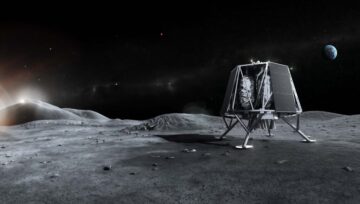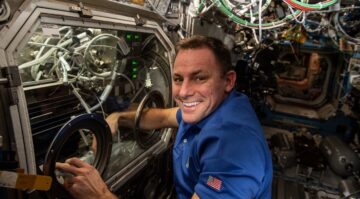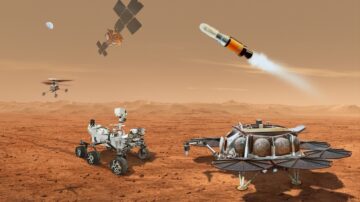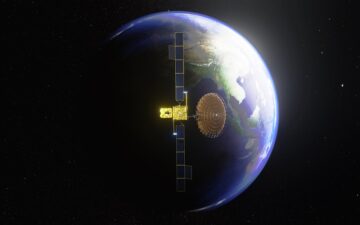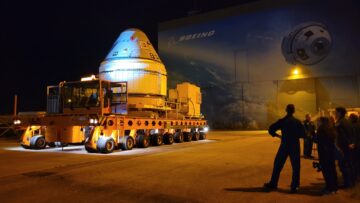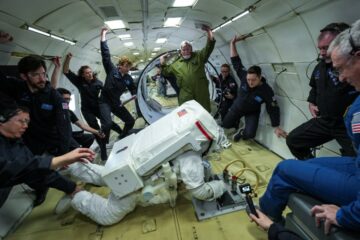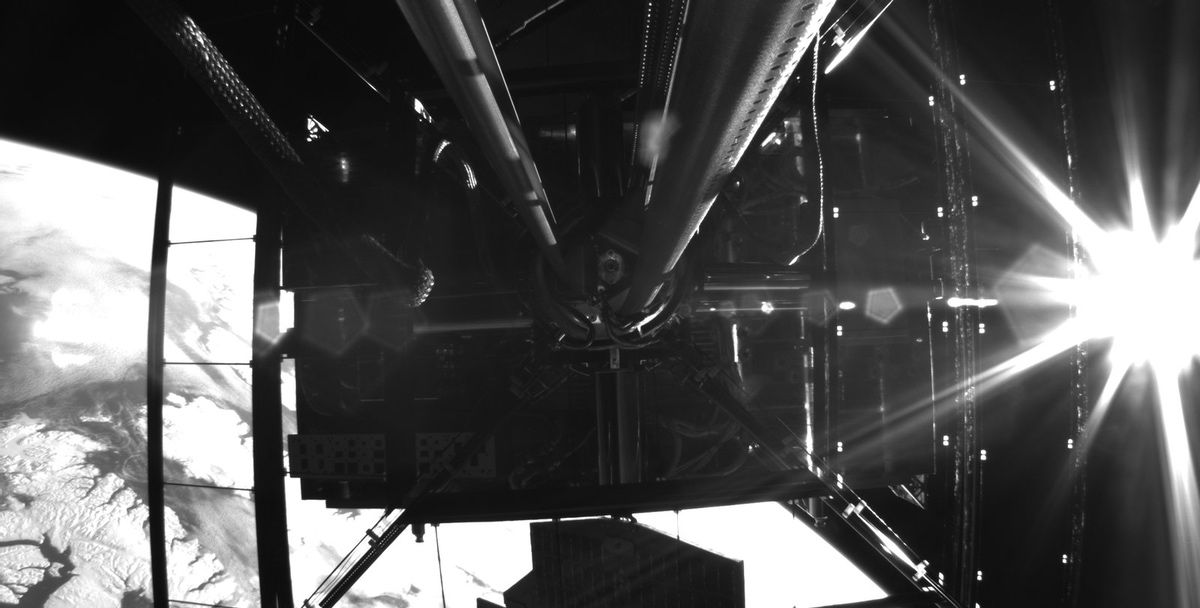
WASHINGTON — Advocates of space-based solar power are criticizing a NASA report that offered a skeptical assessment of that technology’s ability to provide low-cost green energy.
The report, released Jan. 10 by NASA’s Office of Technology, Policy and Strategy (OTPS), examined two previously published architectures for generating electrical power in space and transmitting it to Earth by microwaves, known as space-based solar power (SBSP). The report calculated the lifecycle costs of those architectures as well as the greenhouse emissions their development would produce.
The report concluded that one architecture would produce electricity at a cost of $0.61 per kilowatt-hour, and the other at $1.59 per kilowatt-hour. By contrast, terrestrial renewable systems, such as wind, hydropower and terrestrial solar plants, produce energy at $0.02 to $0.05 per kilowatt-hour.
The report also found that the greenhouse gas “emission intensity” of the SBSP systems, or the amount of greenhouse gases produced from building and launching the systems, was much less than the average of the U.S. electric grid today, but similar to terrestrial renewable systems.
“We found that these space-based solar power designs are expensive. They are 12 to 80 times more expensive than if you were going to have renewable energy on the ground,” said Erica Rodgers, science and technology partnership forum lead in NASA’s Office of the Chief Technologist, in a presentation at the AIAA SciTech Forum conference where the agency released the report.
However, advocates of SBSP have criticized NASA’s cost assessment, in particular the assumptions used for it. “The things that I thought were most admirable were the general methodology, the modeling and the economic emphasis,” said John Mankins, a former NASA official who led an earlier agency study of SBSP in the late 1990s, of the new report in an interview. “They looked at lots of different cases and tried to model a wide variety of different parameters.”
What he took issue with in the report are the assumptions and the data inputs for that modeling. “It seems to be driven entirely by a wide variety of assumptions that are, in combination, the worst possible of the worst possible cases from years ago.”
One example is launch, which accounts for more than 70% of the overall costs of each of the two architectures studied by NASA. The study assumed launch costs of $1,000 per kilogram, plus a 15% “block buy” discount. That struck Mankins as pessimistic, citing SpaceX’s development of Starship and work by other companies, particularly since the NASA study assumed the SBSP system would be launched in the 2040s.
“If it was really true that everybody believed that there was never going to be any improvement in launch beyond the Falcon 9 reusable, I don’t think Blue Origin would be wasting their time working on New Glenn,” he said.
Launch costs could be further reduced, he noted, if electric propulsion is used to transport elements of the system from low Earth orbit to geostationary orbit, rather than the NASA study’s approach of refueling Starship in LEO — similar to the approach it is using for the Starship lunar lander — to carry payloads to GEO.
The NASA study did address the baseline model’s sensitivity to factors such as lower launch costs, use of electric propulsion and assuming a longer lifetime for components in GEO than the 10 years included in the baseline. Incorporating all of those factors reduces the electricity costs of the SBSP systems to levels similar to terrestrial renewable alternatives.
“That’s just weird,” Mankins said of that approach. A typical such study, he said, would pick a “middle of the road” scenario as the baseline and see how factors can either increase or decrease costs. He also criticized the report for not incorporating much of recent research on SBSP technologies.
Other organizations that have promoted SBSP, like the National Space Society (NSS), also critiqued the report. In a Jan. 17 statement, it argued that the report “stopped short of a thorough examination of the real costs and promise” of SBSP, citing launch costs and other factors.
“NSS welcomes the recognition of the importance of space solar power in the OTPS report and looks forward to providing input to NASA to clarify and enhance the conclusions,” said Dale Skran, chief operating officer of the NSS.
Another advocacy group, the Space Frontier Foundation, said the report is evidence that the U.S. government as well as companies should take the technology seriously despite the conclusions of the baseline model. “This report retires the concerns that space-based solar power is science fiction, and shows that NASA and the U.S. government are recognizing the climate-friendly economic benefits of global leadership of this new energy system,” said Sean Mahoney, executive director of the organization.
The report, which NASA announced plans to produce in 2022, comes as other countries and organizations pursue SBSP studies. The European Space Agency is funding a project called Solaris to examine the feasibility of SBSP. China, Japan and the United Kingdom have performed their own analysis of the technology.
That interest in SBSP was one factor in NASA’s decision to conduct this study, Rodgers said. “We were motivated because space-based solar power research is picking up globally. It’s been accelerating over the past five years,” she said at the AIAA conference. “We wanted to better understand why there’s this acceleration.”
Mankins said he was concerned that the pessimistic NASA report might dampen some of that global interest. “That will have a significant chilling influence, particularly in Europe, the U.K. and the U.S.,” he said, “Any document that comes out with the [NASA] meatball on it is regarded almost as gospel.”
There is a small amount of SBSP research in the United States taking place outside of NASA. The California Institute of Technology announced Jan. 16 that it had completed its first in-space test of SBSP technologies, called Space Solar Power Demonstrator 1. That featured three experiments to test deployable structures, photovoltaic cells and wireless power beaming that were flown as a hosted payload on the Vigoride-5 tug by Momentus last January.
Those tests were largely successful, Caltech professors involved in the project described in a presentation last October. However, they said they did not immediately plan to fly a second set of experiments, electing to first perform additional work in the lab for the privately funded project.
“Solar power beamed from space at commercial rates, lighting the globe, is still a future prospect,” Caltech President Thomas Rosenbaum said in a statement about the end of the experiment. “But this critical mission demonstrated that it should be an achievable future.”
- SEO Powered Content & PR Distribution. Get Amplified Today.
- PlatoData.Network Vertical Generative Ai. Empower Yourself. Access Here.
- PlatoAiStream. Web3 Intelligence. Knowledge Amplified. Access Here.
- PlatoESG. Carbon, CleanTech, Energy, Environment, Solar, Waste Management. Access Here.
- PlatoHealth. Biotech and Clinical Trials Intelligence. Access Here.
- Source: https://spacenews.com/nasa-report-offers-pessimistic-take-on-space-based-solar-power/
- :is
- :not
- :where
- $UP
- 000
- 1
- 10
- 12
- 15%
- 16
- 17
- 80
- 9
- a
- ability
- About
- accelerating
- acceleration
- Accounts
- achievable
- Additional
- address
- admirable
- advocacy
- advocates
- agency
- ago
- All
- almost
- also
- alternatives
- amount
- an
- analysis
- and
- announced
- any
- approach
- architecture
- ARE
- argued
- AS
- assessment
- assumed
- assumptions
- At
- average
- Baseline
- BE
- because
- been
- believed
- benefits
- Better
- Beyond
- Blue
- blue origin
- Building
- but
- by
- calculated
- california
- called
- CAN
- carry
- cases
- Cells
- chief
- Chief Operating Officer
- China
- citing
- combination
- comes
- commercial
- Companies
- Completed
- components
- concerned
- Concerns
- concluded
- Conclusions
- Conduct
- Conference
- contrast
- Cost
- Costs
- could
- countries
- critical
- critiqued
- data
- decision
- decrease
- demonstrated
- described
- designs
- Despite
- Development
- DID
- different
- Director
- Discount
- document
- Dont
- driven
- each
- Earlier
- earth
- Economic
- either
- Electric
- electricity
- elements
- Emissions
- emphasis
- end
- energy
- enhance
- entirely
- Erica
- Europe
- European
- European Space Agency
- everybody
- evidence
- examination
- examine
- example
- executive
- Executive Director
- expensive
- experiment
- experiments
- factor
- factors
- falcon
- Falcon 9
- feasibility
- featured
- Fiction
- First
- five
- For
- Former
- Forum
- Forward
- found
- Foundation
- from
- Frontier
- funded
- funding
- further
- future
- GAS
- General
- generating
- Global
- global interest
- Globally
- globe
- going
- Government
- Green
- green energy
- greenhouse gas
- Grid
- Ground
- Group
- had
- Have
- he
- hosted
- How
- However
- HTTPS
- Hydropower
- i
- if
- immediately
- importance
- improvement
- in
- included
- incorporating
- Increase
- influence
- input
- inputs
- Institute
- interest
- Interview
- involved
- issue
- IT
- ITS
- Jan
- January
- Japan
- John
- jpg
- just
- Kingdom
- known
- lab
- largely
- Last
- Late
- launch
- launched
- launching
- lead
- Leadership
- Led
- LEO
- less
- levels
- lifecycle
- lifetime
- Lighting
- like
- longer
- looked
- LOOKS
- lots
- Low
- low-cost
- lower
- Lunar
- lunar lander
- Methodology
- might
- Mission
- model
- modeling
- more
- most
- motivated
- much
- Nasa
- National
- never
- New
- noted
- october
- of
- offered
- Offers
- Office
- Officer
- official
- on
- ONE
- operating
- or
- Orbit
- organization
- organizations
- Origin
- Other
- out
- outside
- over
- overall
- own
- parameters
- particular
- particularly
- Partnership
- past
- per
- perform
- performed
- pessimistic
- pick
- picking
- Place
- plan
- plans
- plants
- plato
- Plato Data Intelligence
- PlatoData
- plus
- policy
- possible
- power
- presentation
- president
- previously
- produce
- Produced
- project
- Promoted
- propulsion
- prospect
- provide
- providing
- published
- pursue
- Rates
- rather
- real
- really
- recent
- recognition
- recognizing
- Reduced
- reduces
- Refueling
- regarded
- released
- Renewable
- renewable energy
- report
- research
- reusable
- rodgers
- s
- Said
- scenario
- Science
- Science and Technology
- Science Fiction
- Sean
- Second
- see
- seems
- Sensitivity
- seriously
- set
- she
- Short
- should
- Shows
- significant
- similar
- since
- skeptical
- small
- Society
- solar
- Solar Power
- Solaris
- some
- Space
- space-based
- starship
- Statement
- States
- Still
- Strategy
- structures
- studied
- studies
- Study
- successful
- such
- system
- Systems
- Take
- taking
- Technologies
- technologist
- Technology
- terrestrial
- test
- tests
- than
- that
- The
- the United Kingdom
- their
- There.
- These
- they
- things
- Think
- this
- those
- thought
- three
- time
- times
- to
- today
- took
- transport
- tried
- true
- two
- typical
- U.K.
- u.s.
- U.S. government
- understand
- United
- United Kingdom
- United States
- use
- used
- using
- variety
- wanted
- was
- Welcomes
- WELL
- were
- which
- WHO
- why
- wide
- will
- wind
- wireless
- with
- Work
- working
- Worst
- would
- years
- you
- zephyrnet


